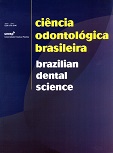Avaliação mecânica e microestrutural da interface ceramo-cerâmica
DOI:
https://doi.org/10.14295/bds.2005.v8i2.386Abstract
O propósito deste estudo foi avaliar a resistência e caracterizar química e microestruturalmente, através da espectrometria dispersiva de raios X (EDX) e microscopia eletrônica de varredura (MEV), a interface ceramo cerâmica de dois grupos: A)IPS Empress 2/Empress 2 cerâmico, B)In Ceram Alumina/Vitadur Alfa. Foram confeccionadas dez amostras de cada grupo composta de infra-estrutura que apresenta uma extremidade maior de dimensões de 5,0mm de diâmetro x 5,0mm de comprimento, um estreitamento de 1,0mm formando uma extremidade menor de 4,0mm de diâmetro x 2,0mm de comprimento, sendo esta superfície aplicada cerâmica de recobrimento apresentando 4,0mm x 3,0mm de comprimento. Os grupos A e B, foram submetidos ao teste de cisalhamento numa máquina Instron (modelo 4301) a uma velocidade de 0,5mm/min até a fratura. Os resultados foram avaliados utilizando ANOVA. A resistência ao cisalhamento do grupo A foi estatisticamente superior em relação ao grupo B, p<0,5, e microestruturalmente, foi observada no grupo B uma predominância de deslocamento total do recobrimento em relação a infra-estrutura, enquanto no grupo A observou-se um deslocamento parcial. Concluiu-se que o grupo A apresentou uma maior adesividade ceramo-cerâmica, quando avaliado mecânica e microestruturalmente.Downloads
Downloads
Published
How to Cite
Issue
Section
License
Brazilian Dental Science uses the Creative Commons (CC-BY 4.0) license, thus preserving the integrity of articles in an open access environment. The journal allows the author to retain publishing rights without restrictions.
=================




























